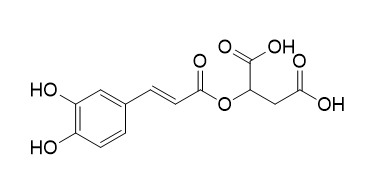Caffeoylmalic acid
Caffeoylmalic acid has neurosedative and antioxidant activities.
Inquire / Order:
manager@chemfaces.com
Technical Inquiries:
service@chemfaces.com
Tel:
+86-27-84237783
Fax:
+86-27-84254680
Address:
1 Building, No. 83, CheCheng Rd., Wuhan Economic and Technological Development Zone, Wuhan, Hubei 430056, PRC
Providing storage is as stated on the product vial and the vial is kept tightly sealed, the product can be stored for up to
24 months(2-8C).
Wherever possible, you should prepare and use solutions on the same day. However, if you need to make up stock solutions in advance, we recommend that you store the solution as aliquots in tightly sealed vials at -20C. Generally, these will be useable for up to two weeks. Before use, and prior to opening the vial we recommend that you allow your product to equilibrate to room temperature for at least 1 hour.
Need more advice on solubility, usage and handling? Please email to: service@chemfaces.com
The packaging of the product may have turned upside down during transportation, resulting in the natural compounds adhering to the neck or cap of the vial. take the vial out of its packaging and gently shake to let the compounds fall to the bottom of the vial. for liquid products, centrifuge at 200-500 RPM to gather the liquid at the bottom of the vial. try to avoid loss or contamination during handling.
Antioxidants (Basel).2021, 10(10):1620.
J Cachexia Sarcopenia Muscle.2022, 13(6):3149-3162.
Phytomedicine.2021, 83:153483.
Nutrients.2024, 16(19):3266.
Foods.2023, 12(12):2412.
BioRxiv-The Preprint server for biology2023, 586957.
Sci Rep.2019, 9:19059
Mol Biol Rep.2023, 50(5):4029-4038.
Microorganisms.2021, 9(12):2514.
Mutlu Yanic S, Ates EG. JOTCSA.2023, 10(4);893-902.
Related and Featured Products
Arzneimittelforschung, 2000, 50(01):16-23.
Neurosedative and antioxidant activities of phenylpropanoids from ballota nigra.[Reference:
WebLink]
Ballota nigra is a European plant known for its neurosedative properties. In this study, the ability of five phenylpropanoids (verbascoside, forsythoside B, arenarioside, ballotetroside, and Caffeoylmalic acid) isolated from a hydroalcoholic extract, to bind to benzodiazepine, dopaminergic, and morphinic receptors was investigated.
METHODS AND RESULTS:
To carry out these studies, affinity tests with rat striata, entire brains and receptor rich preparations were employed. In addition, the phenolic aspect of these five phenylpropanoid esters led to investigate antioxidant activities using cell-free experiments and cellular experiments including isolated polymorphonuclear neutrophils (PMN). Effects of phenylpropanoid esters against reactive oxygen species as superoxide anion, peroxide hydrogen, hypochlorous acid and hydroxyl radical were tested. These molecules are liberated by PMN during inflammatory disorders, so that reproduction of this process in vitro stimulating PMN by chemical stimulants was undertaken. Results show that four of the five compounds are able to bind to the studied receptors. Inhibitory concentrations at 50% were determined and vary from 0.4 to 4.7 mg/ml. This may be in relation with the Ballota nigra known neurosedative activities.
CONCLUSIONS:
Results concerning antioxidant investigations evidence an ability to scavenge reactive oxygen species. Inhibitory concentrations at 50% obtained are comparable to those of known antioxidant drugs (mesna or N-acetyl cysteine). Moreover, the use of different stimuli having various pathways of action on PMN oxidative metabolism permits to establish that each phenylpropanoid ester has its own particular way of action by using proteine kinase C or phospholipase C pathways.
Food chemistry., 20 Sep 2013, 146:404-411
Cool-cultivated red leaf lettuce accumulates cyanidin-3-O-(6″-O-malonyl)-glucoside and caffeoylmalic acid.[Reference:
WebLink]
METHODS AND RESULTS:
Cultivating lettuce in greenhouses at low temperatures improves its CO2-balance and may increase its content of flavonoid glycosides and phenolic acids. We cultivated 5weeks old red leaf lettuce seedlings at 20/15°C (day/night) or 12/7°C until plants reached comparable growth stages: small heads were harvested after 13 (warm) and 26 (cool)days, while mature heads were harvested after 26 (warm) or 52 (cool)days. Additionally, some plants were cultivated first cool then warm and vice versa (39days). Cool-cultivated small heads had higher concentrations of cyanidin-3-O-(6″-O-malonyl)-glucoside and Caffeoylmalic acid than warm-cultivated ones but we detected no differences concerning quercetin and luteolin glycosides or di-O-caffeoyltartaric and 5-O-caffeoylquinic acid. Regarding mature heads, there were only differences concerning cyanidin-3-O-(6″-O-malonyl)-glucoside.
CONCLUSIONS:
We therefore suggest that only cyanidin-3-O-(6″-O-malonyl)-glucoside was truly responsive to temperatures alone. Previously reported contrasting effects may rather be due to comparison of different growth stages or interactive effects with radiation.



